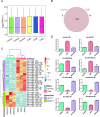Identification and characterization of miRNAs involved in cold acclimation of zebrafish ZF4 cells
- PMID: 31923196
- PMCID: PMC6953832
- DOI: 10.1371/journal.pone.0226905
Identification and characterization of miRNAs involved in cold acclimation of zebrafish ZF4 cells
Abstract
MicroRNAs (miRNAs) play vital roles in various biological processes under multiple stress conditions by leading to mRNA cleavage or translational repression. However, the detailed roles of miRNAs in cold acclimation in fish are still unclear. In the present study, high-throughput sequencing was performed to identify miRNAs from 6 small RNA libraries from the zebrafish embryonic fibroblast ZF4 cells under control (28°C, 30 days) and cold-acclimation (18°C, 30 days) conditions. A total of 414 miRNAs, 349 known and 65 novel, were identified. Among those miRNAs, 24 (19 known and 5 novel) were up-regulated, and 23 (9 known and 14 novel) were down-regulated in cold acclimated cells. The Gene Ontology (GO) and Kyoto Encyclopaedia of Genes and Genomes (KEGG) enrichment analyses indicated that the target genes of known differentially expressed miRNAs (DE-miRNA) are involved in cold acclimation by regulation of phosphorylation, cell junction, intracellular signal transduction, ECM-receptor interaction and so on. Moreover, both miR-100-3p inhibitor and miR-16b mimics could protect ZF4 cells under cold stress, indicating the involvement of miRNA in cold acclimation. Further study showed that miR-100-3p and miR-16b could regulate inversely the expression of their target gene (atad5a, cyp2ae1, lamp1, rilp, atxn7, tnika, btbd9), and that overexpression of miR-100-3p disturbed the early embryonic development of zebrafish. In summary, the present data show that miRNAs are closely involved in cold acclimation in zebrafish ZF4 cells and provide information for further understanding of the roles of miRNAs in cold acclimation in fish.
Conflict of interest statement
The authors have declared that no competing interests exist.
Figures






References
Publication types
MeSH terms
Substances
LinkOut - more resources
Full Text Sources
Molecular Biology Databases
Miscellaneous

